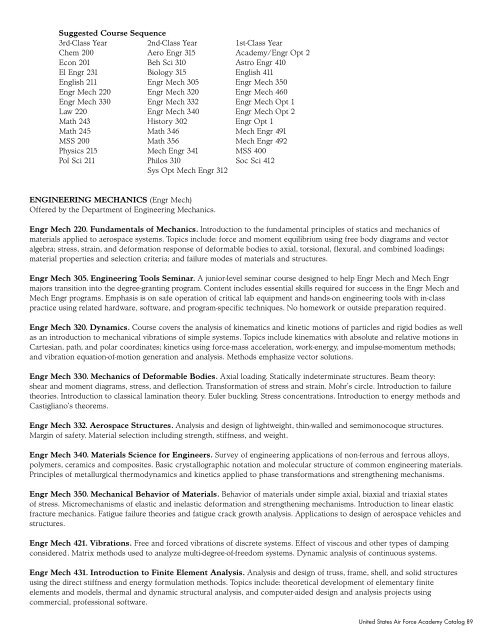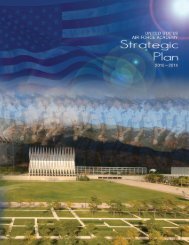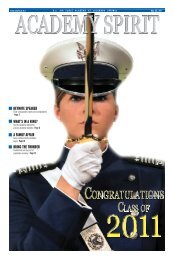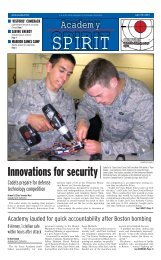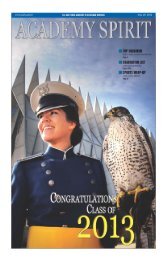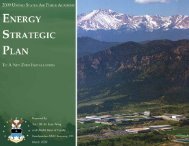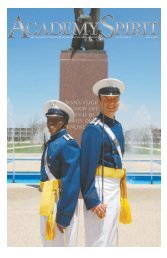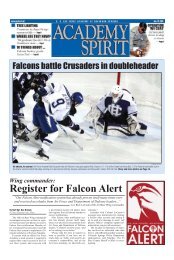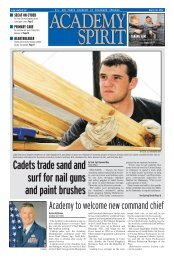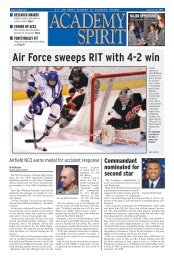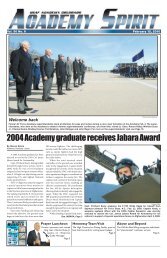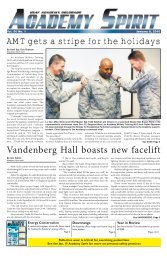2008-2009 Catalog - United States Air Force Academy
2008-2009 Catalog - United States Air Force Academy
2008-2009 Catalog - United States Air Force Academy
You also want an ePaper? Increase the reach of your titles
YUMPU automatically turns print PDFs into web optimized ePapers that Google loves.
Suggested Course Sequence<br />
3rd-Class Year 2nd-Class Year 1st-Class Year<br />
Chem 200 Aero Engr 315 <strong>Academy</strong>/Engr Opt 2<br />
Econ 201 Beh Sci 310 Astro Engr 410<br />
El Engr 231 Biology 315 English 411<br />
English 211 Engr Mech 305 Engr Mech 350<br />
Engr Mech 220 Engr Mech 320 Engr Mech 460<br />
Engr Mech 330 Engr Mech 332 Engr Mech Opt 1<br />
Law 220 Engr Mech 340 Engr Mech Opt 2<br />
Math 243 History 302 Engr Opt 1<br />
Math 245 Math 346 Mech Engr 491<br />
MSS 200 Math 356 Mech Engr 492<br />
Physics 215 Mech Engr 341 MSS 400<br />
Pol Sci 211 Philos 310 Soc Sci 412<br />
Sys Opt Mech Engr 312<br />
ENGINEERING MECHANICS (Engr Mech)<br />
Offered by the Department of Engineering Mechanics.<br />
Engr Mech 220. Fundamentals of Mechanics. Introduction to the fundamental principles of statics and mechanics of<br />
materials applied to aerospace systems. Topics include: force and moment equilibrium using free body diagrams and vector<br />
algebra; stress, strain, and deformation response of deformable bodies to axial, torsional, flexural, and combined loadings;<br />
material properties and selection criteria; and failure modes of materials and structures.<br />
Engr Mech 305. Engineering Tools Seminar. A junior-level seminar course designed to help Engr Mech and Mech Engr<br />
majors transition into the degree-granting program. Content includes essential skills required for success in the Engr Mech and<br />
Mech Engr programs. Emphasis is on safe operation of critical lab equipment and hands-on engineering tools with in-class<br />
practice using related hardware, software, and program-specific techniques. No homework or outside preparation required.<br />
Engr Mech 320. Dynamics. Course covers the analysis of kinematics and kinetic motions of particles and rigid bodies as well<br />
as an introduction to mechanical vibrations of simple systems. Topics include kinematics with absolute and relative motions in<br />
Cartesian, path, and polar coordinates; kinetics using force-mass acceleration, work-energy, and impulse-momentum methods;<br />
and vibration equation-of-motion generation and analysis. Methods emphasize vector solutions.<br />
Engr Mech 330. Mechanics of Deformable Bodies. Axial loading. Statically indeterminate structures. Beam theory:<br />
shear and moment diagrams, stress, and deflection. Transformation of stress and strain. Mohr’s circle. Introduction to failure<br />
theories. Introduction to classical lamination theory. Euler buckling. Stress concentrations. Introduction to energy methods and<br />
Castigliano’s theorems.<br />
Engr Mech 332. Aerospace Structures. Analysis and design of lightweight, thin-walled and semimonocoque structures.<br />
Margin of safety. Material selection including strength, stiffness, and weight.<br />
Engr Mech 340. Materials Science for Engineers. Survey of engineering applications of non-ferrous and ferrous alloys,<br />
polymers, ceramics and composites. Basic crystallographic notation and molecular structure of common engineering materials.<br />
Principles of metallurgical thermodynamics and kinetics applied to phase transformations and strengthening mechanisms.<br />
Engr Mech 350. Mechanical Behavior of Materials. Behavior of materials under simple axial, biaxial and triaxial states<br />
of stress. Micromechanisms of elastic and inelastic deformation and strengthening mechanisms. Introduction to linear elastic<br />
fracture mechanics. Fatigue failure theories and fatigue crack growth analysis. Applications to design of aerospace vehicles and<br />
structures.<br />
Engr Mech 421. Vibrations. Free and forced vibrations of discrete systems. Effect of viscous and other types of damping<br />
considered. Matrix methods used to analyze multi-degree-of-freedom systems. Dynamic analysis of continuous systems.<br />
Engr Mech 431. Introduction to Finite Element Analysis. Analysis and design of truss, frame, shell, and solid structures<br />
using the direct stiffness and energy formulation methods. Topics include: theoretical development of elementary finite<br />
elements and models, thermal and dynamic structural analysis, and computer-aided design and analysis projects using<br />
commercial, professional software.<br />
<strong>United</strong> <strong>States</strong> <strong>Air</strong> <strong>Force</strong> <strong>Academy</strong> <strong>Catalog</strong> 89


